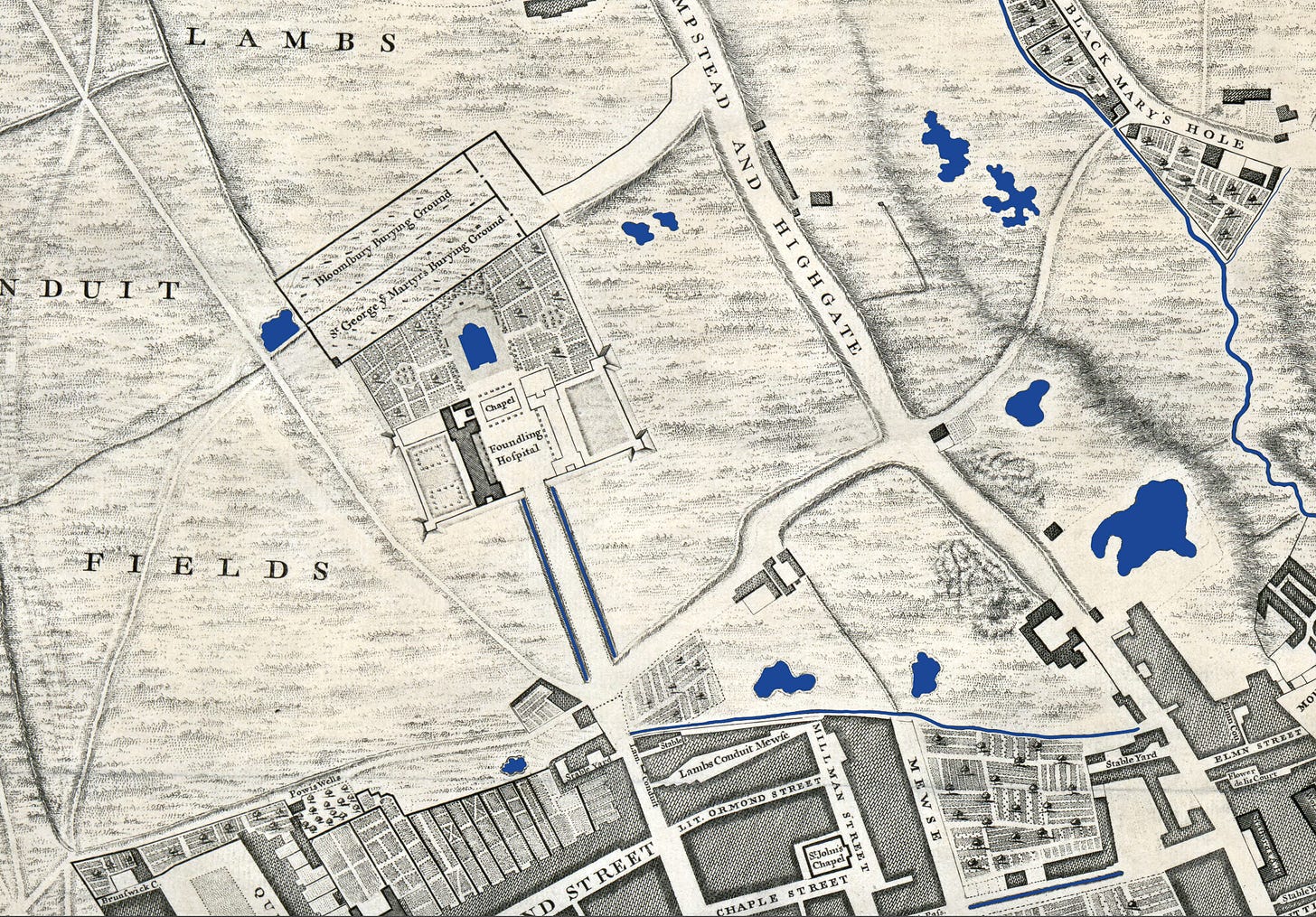Welcome to the Friday edition of Londonist: Time Machine for paying subscribers, with a generous teaser for everyone else.
Today’s article is a follow-on to the last newsletter, in which I published a newly colourised map of Bloomsbury from 1746 (see it here if you haven’t already). Not only was the area largely fields at the time, but it was also riddled with ponds, mires and rivulets. Where exactly where they? What’s on their sites today? And what has all this to do with Kenneth Williams? Read on to find out more.
First, though, the History Radar.
History Radar
Upcoming events of interest to London history fans.
⛪︎ CHRISTOPHER WREN: On 25 November, Guildhall Library hosts a talk about the life and work of Christopher Wren, by City Guide and Lecturer Jill Finch. Hear the story of how Wren became Professor at Gresham College, a founder of the Royal Society and architect of St Paul’s Cathedral, via online livestream.
🎄 CHARTERHOUSE CHRISTMAS FAIR: The beautiful and achingly historic Charterhouse in Clerkenwell hosts its Christmas fair on 26 November, so is likely to be less busy than other Christmas markets which run at weekends. Seasonal refreshments, accessories, crafts, clothes and homewares are available, while you sneak a peek at the ancient buildings.
🖼️ WESTMINSTER MOSAICS: Also on 26 November, Peter Howell, former Chairman of the Victorian Society, gives an online talk about the interior of Westminster Cathedral. JF Bentley, the cathedral's architect, intended that the interior should be covered in marble revetment and mosaics -- hear about some of those mosaics, designed by J R Clayton, Robert Anning Bell and George Jack.
🏗️ LONDON'S INDUSTRIAL HERITAGE: On 27 November, the Greater London Industrial Archaeology Society takes over the Cinema Museum in Kennington for an evening of historical films from the John Huntley Archive featuring London’s industrial heritage. Watch films from the early 20th century through to the 1960s on subjects such as railways, canals and other transport, industry, utilities and much more, all shot in London.
✍️ DICKENSIAN CHRISTMAS TOUR: Also on 27 November, the Charles Dickens Museum -- reliably one of the most festively decorated spots in London each year -- goes extra bauble-y for a Dickensian Christmas tour. Visit the house after hours and meet Dickens' close friend John Forster, who will take you through Dickens’s historic London home and with tales of Christmases past.
🔔 CATHEDRAL TOUR: Join a guide for an hour-long tour of Southwark Cathedral on 28 November, covering elements of the building's 900-year history, including why a former bishop is buried here, and why Southwark Cathedral is strongly associated with Winchester.
🎸 CHRISTMAS LATES: Also on 28 November, Handel & Hendrix stays open for a Christmas late, a chance to see the neighbouring houses -- home at different times (obvs) to George Frideric Handel and Jimi Hendrix -- decorated for the festive season. The historic rooms are adorned with decorations inspired by music, and mulled cider is available as you get stuck into Christmas crafts and activities.
🤶 FULHAM PALACE CHRISTMAS FAIR: Another chance to shop historically, with a Christmas fair at Fulham Palace (29-30 November). There's a special adults-only preview evening on the Friday, before the Christmas fair opens to everyone on Saturday. Browse small business stalls selling gifts and food items, tuck into festive refreshments including mince pies and mulled wine, enjoy performances by local choirs in the courtyard, and keep the kids occupied with crafts and a Christmas trail.
🎨 CHURCHILL IN CARTOONS: The Imperial War Museum marks 150 years since the birth of Winston Churchill with free exhibition Churchill in Cartoons: Satirising a Statesman. View satirical cartoons from Churchill's time in the public eye and find out how they influenced perceptions of him, and continue to shape our perception today. Opens on 29 November and rums through till February.
🍷 FORTY HALL CHRISTMAS FAYRE: And yet more historic shopping as Forty Hall in Enfield hosts a two-day Christmas fayre (30 Nov-1 Dec) — both inside the period rooms and out in the courtyard — showcasing local businesses. Mulled wine, mince pies and other seasonal treats are available to guzzle after you've browsed.
The dehydration of Bloomsbury
When did you last see someone fall into a pond in Bloomsbury? You didn’t, because there aren’t any — at least not in public spaces. The only water feature I can think of is the bubbly fountain in Russell Square, and that’s switched off as often as not.
Bloomsbury is dry. As dry as the bones in its Grant Museum of Zoology.
That wasn’t always the case. Traditionally, the area was an amphibian’s wet dream. We can see this clearly in my newly colourised panel from the John Rocque map of 1746. Just look at all the pools in this eastern section:

Every single one of these ponds was drained long ago. The River Fleet got buried in a sewer; the ditches inhumated. Lamb’s Conduit, an artificial Tudor watercourse, has vanished in all but name. Bloomsbury got dehydrated.
Armed with my newly colourised Rocque map, we can now work out the locations of these erstwhile mires. I craftily applied the colours onto separate layers so, for example, buildings in red are on a separate layer to fields in green, and churches in yellow. Using Photoshop, I can turn off most of these layers, and get a map that highlights only the water features. Like this:
Now that the ponds and streams stand out, we can see that they fall into a vaguely circular pattern. It’s an aquatic ring; a torus of moisture. You could almost circumnavigate the area by boat. All very interesting. But what, I suspect, you really want to see is how this matches up to the modern street plan. So here goes:






